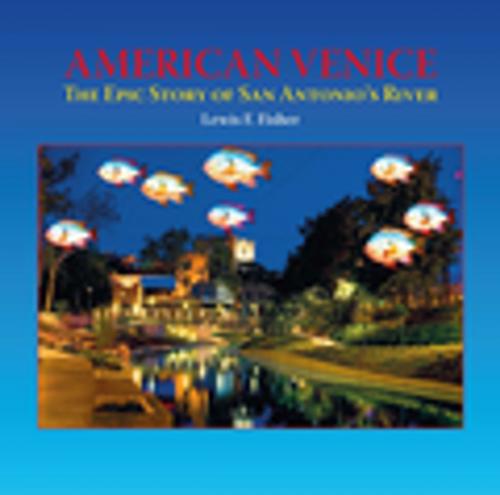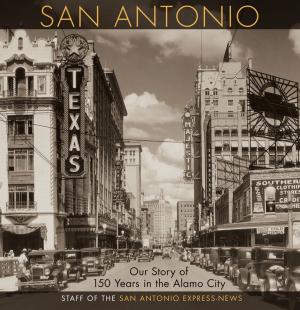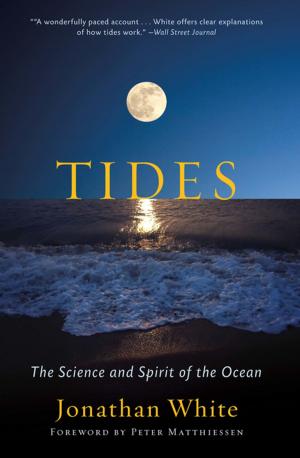American Venice
The Epic Story of San Antonio's River
Nonfiction, History, Americas, United States, 20th Century| Author: | Lewis F. Fisher | ISBN: | 9781595342652 |
| Publisher: | Trinity University Press | Publication: | February 23, 2015 |
| Imprint: | Maverick Books | Language: | English |
| Author: | Lewis F. Fisher |
| ISBN: | 9781595342652 |
| Publisher: | Trinity University Press |
| Publication: | February 23, 2015 |
| Imprint: | Maverick Books |
| Language: | English |
In American Venice: The Epic Story of San Antonio’s River, Lewis F. Fisher uncovers the evolution of San Antonio’s beloved River Walk. He shares how San Antonians refused to give up on the vital water source that provided for them from before the city’s beginnings. In 1941 neglect, civic uprisings, and bursts of creativity culminated in the completion of a Works Projects Administration project designed by Robert H. H. Hugman.
The resulting River Walk languished for years but enjoyed renewed interest during the 1968 World’s Fair, held in San Antonio, and has since become the center of the city’s cultural and historical narrative.
The real story [of the River Walk] is a bit less Hollywood but far more interesting . . . With a growing number of cities facing issues of water supply, urban runoff, flooding, and ways of rebuilding better after a disaster, the San Antonio River Walk remains a great example of getting it right,” writes Irby Hightower, co-chair of the San Antonio River Oversight Committee.
In this updated and expanded edition of River Walk: The Epic Story of San Antonio’s River, Fisher offers more fascinating stories about the River Walk’s evolution, bringing to light new facts and sharing historical images that he has since discovered. The update includes information about the Museum and Mission Reaches, two expansions of the River Walk that are vital to San Antonio’s continued growth as the seventh largest city in the country.
Fisher starts his story with the first written records of the river, in the 1690s, and continues through the 1800s and the flood of 1921, to debates over transforming the river and its eventual role as the crown jewel of Texas, and finally to its recent expansion. More than a community attraction, the River Walk’s banks are also a giant botanical garden full of plants and trees. Indeed, the American Society for Horticulture has named the River Walk a Horticultural Landmark. As Fisher says, the River Walk remains a work in progress, one forever precarious and unfinished yet standing before the world as a triumph of enterprise and human imagination.”
The resulting River Walk languished for years but enjoyed renewed interest during the 1968 World’s Fair, held in San Antonio, and has since become the center of the city’s cultural and historical narrative.
The real story [of the River Walk] is a bit less Hollywood but far more interesting . . . With a growing number of cities facing issues of water supply, urban runoff, flooding, and ways of rebuilding better after a disaster, the San Antonio River Walk remains a great example of getting it right,” writes Irby Hightower, co-chair of the San Antonio River Oversight Committee.
In this updated and expanded edition of River Walk: The Epic Story of San Antonio’s River, Fisher offers more fascinating stories about the River Walk’s evolution, bringing to light new facts and sharing historical images that he has since discovered. The update includes information about the Museum and Mission Reaches, two expansions of the River Walk that are vital to San Antonio’s continued growth as the seventh largest city in the country.
Fisher starts his story with the first written records of the river, in the 1690s, and continues through the 1800s and the flood of 1921, to debates over transforming the river and its eventual role as the crown jewel of Texas, and finally to its recent expansion. More than a community attraction, the River Walk’s banks are also a giant botanical garden full of plants and trees. Indeed, the American Society for Horticulture has named the River Walk a Horticultural Landmark. As Fisher says, the River Walk remains a work in progress, one forever precarious and unfinished yet standing before the world as a triumph of enterprise and human imagination.”
In American Venice: The Epic Story of San Antonio’s River, Lewis F. Fisher uncovers the evolution of San Antonio’s beloved River Walk. He shares how San Antonians refused to give up on the vital water source that provided for them from before the city’s beginnings. In 1941 neglect, civic uprisings, and bursts of creativity culminated in the completion of a Works Projects Administration project designed by Robert H. H. Hugman.
The resulting River Walk languished for years but enjoyed renewed interest during the 1968 World’s Fair, held in San Antonio, and has since become the center of the city’s cultural and historical narrative.
The real story [of the River Walk] is a bit less Hollywood but far more interesting . . . With a growing number of cities facing issues of water supply, urban runoff, flooding, and ways of rebuilding better after a disaster, the San Antonio River Walk remains a great example of getting it right,” writes Irby Hightower, co-chair of the San Antonio River Oversight Committee.
In this updated and expanded edition of River Walk: The Epic Story of San Antonio’s River, Fisher offers more fascinating stories about the River Walk’s evolution, bringing to light new facts and sharing historical images that he has since discovered. The update includes information about the Museum and Mission Reaches, two expansions of the River Walk that are vital to San Antonio’s continued growth as the seventh largest city in the country.
Fisher starts his story with the first written records of the river, in the 1690s, and continues through the 1800s and the flood of 1921, to debates over transforming the river and its eventual role as the crown jewel of Texas, and finally to its recent expansion. More than a community attraction, the River Walk’s banks are also a giant botanical garden full of plants and trees. Indeed, the American Society for Horticulture has named the River Walk a Horticultural Landmark. As Fisher says, the River Walk remains a work in progress, one forever precarious and unfinished yet standing before the world as a triumph of enterprise and human imagination.”
The resulting River Walk languished for years but enjoyed renewed interest during the 1968 World’s Fair, held in San Antonio, and has since become the center of the city’s cultural and historical narrative.
The real story [of the River Walk] is a bit less Hollywood but far more interesting . . . With a growing number of cities facing issues of water supply, urban runoff, flooding, and ways of rebuilding better after a disaster, the San Antonio River Walk remains a great example of getting it right,” writes Irby Hightower, co-chair of the San Antonio River Oversight Committee.
In this updated and expanded edition of River Walk: The Epic Story of San Antonio’s River, Fisher offers more fascinating stories about the River Walk’s evolution, bringing to light new facts and sharing historical images that he has since discovered. The update includes information about the Museum and Mission Reaches, two expansions of the River Walk that are vital to San Antonio’s continued growth as the seventh largest city in the country.
Fisher starts his story with the first written records of the river, in the 1690s, and continues through the 1800s and the flood of 1921, to debates over transforming the river and its eventual role as the crown jewel of Texas, and finally to its recent expansion. More than a community attraction, the River Walk’s banks are also a giant botanical garden full of plants and trees. Indeed, the American Society for Horticulture has named the River Walk a Horticultural Landmark. As Fisher says, the River Walk remains a work in progress, one forever precarious and unfinished yet standing before the world as a triumph of enterprise and human imagination.”















